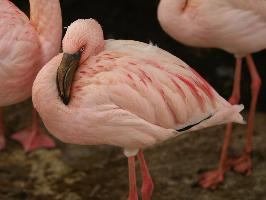
Date biologice
| Durata de viață | 35 r |
|---|
Descrierea animalului
The Lesser Flamingo (Phoeniconaias minor) is a captivating bird species renowned for its striking pink plumage, slender build, and elegant posture. As one of the six flamingo species, it is distinguished by its vibrant coloration, diminutive size, and highly specialized feeding habits. The Lesser Flamingo is the smallest among its relatives, standing at approximately 80 to 90 cm in height and weighing between 1.2 and 2.7 kg. Despite its size, this species exhibits a remarkable adaptability to some of the harshest aquatic environments across its range.Physical Description:
The Lesser Flamingo boasts a delicate yet vivid pink feather coat, which can range from a pale, almost white, pink to a more intense shade depending on its diet. The species is characterized by its long, slender neck and legs, which grant it an air of gracefulness. Its bill is notably large and uniquely shaped, curving downwards to facilitate its filter-feeding habits. The bill is equipped with lamellae, which act as a sieve to trap microorganisms from the water. The eyes are yellow, providing a striking contrast to its pink plumage, while the legs are generally a darker pink or even red hue.
Habitat and Distribution:
Lesser Flamingos favor alkaline or saline lakes and lagoons, where they can be found in large flocks that sometimes number in the thousands. These habitats are often inhospitable to many other species, giving the Lesser Flamingo a niche with minimal competition. The species is predominantly found in the Rift Valley lakes of Eastern Africa, with significant populations also residing in Southern Africa, and parts of Northwestern India and the Middle East.
Behavior and Diet:
The Lesser Flamingo is a highly social bird, living in large colonies that offer protection against predators and increase efficiency in locating food. They are known for their synchronized movements and behaviors, particularly during their elaborate courtship displays, which involve coordinated group dances.
The diet of the Lesser Flamingo primarily consists of algae and diatoms, which they filter from the water with their specially adapted beaks. The pink pigment in their feathers, called carotenoids, is derived from this diet. The intensity of their coloration can vary based on the quantity and quality of these pigments in their food.
Reproduction:
Lesser Flamingos are monogamous, with pairs forming strong bonds. They nest in large colonies, where each pair builds a mud mound to lay a single egg. Both parents take turns incubating the egg, and once hatched, the chick is fed a nutrient-rich secretion produced by both parents. The chicks are born with white down, which gradually turns to grey, and finally adopts the characteristic pink hue as they mature and begin feeding independently.
Conservation Status:
The Lesser Flamingo is classified as Near Threatened by the International Union for Conservation of Nature (IUCN). The species faces threats from habitat loss and degradation, pollution, and disturbance from human activities. Conservation efforts are focused on protecting their habitats, monitoring populations, and raising awareness about the importance of these unique birds.
In conclusion, the Lesser Flamingo is a fascinating and visually stunning bird that plays a crucial role in the ecosystems of some of the world's most extreme aquatic environments. Its unique adaptations, social behavior, and reproductive strategies make it a subject of interest and admiration, underscoring the importance of its conservation for future generations to enjoy.
Animale similare
Fotografii noi cu animale
Top 10 animale
- Dolphin gull (Leucophaeus scoresbii)
- Diana monkey (Cercopithecus diana)
- Moustached guenon (Cercopithecus cephus)
- Greek tortoise (Testudo graeca)
- Stone loach (Barbatula barbatula)
- Galápagos tortoise (Geochelone nigra complex)
- Japanese macaque (Macaca fuscata)
- Russian tortoise (Testudo horsfieldii)
- Common flying dragon (Draco volans)
- Galápagos penguin (Spheniscus mendiculus)
